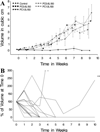Photodynamic therapy of cottontail rabbit papillomavirus-induced papillomas in a severe combined immunodeficient mouse xenograft system
- PMID: 20091778
- PMCID: PMC4459584
- DOI: 10.1002/lary.20709
Photodynamic therapy of cottontail rabbit papillomavirus-induced papillomas in a severe combined immunodeficient mouse xenograft system
Abstract
Objectives/hypothesis: To evaluate the efficacy of photodynamic therapy (PDT) with the phthalocyanine photosensitizer Pc 4 for treating an animal model of recurrent respiratory papillomatosis (RRP).
Methods: Rabbit skin was grafted onto the dorsum of severe combined immunodeficient mice, two xenografts per animal. After the graft healed, it was inoculated with cottontail rabbit papillomavirus (CRPV). When papillomas developed, Pc 4 (0.6 or 1.0 mg/kg) was administered systemically, and 48 hours later, one papilloma of the two on each animal was exposed to 675-nm photoactivating light at either 100 or 150 J/cm(2). In addition to the contralateral tumors, which received Pc 4 but no light, other controls included animals receiving light only or neither agent. Response was assessed by measuring papilloma size with a caliper. Some papillomas and residual skin were harvested for histological assessment.
Results: For the lower-dose PDT regimens, papilloma growth rates were not significantly different from the controls. In contrast, 13 of 15 papillomas receiving the higher Pc 4 dose (1.0 mg/kg) and the higher light fluence (150 J/cm(2)) regressed completely and did not regrow within the observation period of up to 79 days. The response of these papillomas was significantly different from the controls (P < .001). Histological analysis confirmed the absence of residual tumor following complete response and replacement with near-normal epithelium.
Conclusions: Pc 4-PDT is highly effective in treating virally induced (CRPV) papillomas in a murine model of RRP, and thus warrants further study as a treatment for HPV-induced papillomas.
Figures






Similar articles
-
Histological and molecular analysis of cottontail rabbit papillomavirus-induced papillomas treated with hematoporphyrin derivative photodynamic therapy.Arch Otolaryngol Head Neck Surg. 1988 Feb;114(2):175-8. doi: 10.1001/archotol.1988.01860140073024. Arch Otolaryngol Head Neck Surg. 1988. PMID: 2827705
-
Hematoporphyrin derivative therapy of papillomas. Experimental study.Arch Otolaryngol Head Neck Surg. 1986 Jan;112(1):42-6. doi: 10.1001/archotol.1986.03780010044007. Arch Otolaryngol Head Neck Surg. 1986. PMID: 3000329
-
Apoptosis is an early event during phthalocyanine photodynamic therapy-induced ablation of chemically induced squamous papillomas in mouse skin.Photochem Photobiol. 1996 Apr;63(4):547-52. doi: 10.1111/j.1751-1097.1996.tb03082.x. Photochem Photobiol. 1996. PMID: 8934768
-
The rabbit viral skin papillomas and carcinomas: a model for the immunogenetics of HPV-associated carcinogenesis.Clin Dermatol. 1997 Mar-Apr;15(2):237-47. doi: 10.1016/s0738-081x(97)00009-6. Clin Dermatol. 1997. PMID: 9167908 Review. No abstract available.
-
Cottontail rabbit papillomavirus (CRPV) model system to test antiviral and immunotherapeutic strategies.Antivir Chem Chemother. 2005;16(6):355-62. doi: 10.1177/095632020501600602. Antivir Chem Chemother. 2005. PMID: 16331841 Review.
Cited by
-
Recurrent respiratory papillomatosis: current and future perspectives.Ther Clin Risk Manag. 2015 May 5;11:731-8. doi: 10.2147/TCRM.S81825. eCollection 2015. Ther Clin Risk Manag. 2015. PMID: 25999724 Free PMC article. Review.
-
A systematic review of photodynamic therapy as an antiviral treatment: Potential guidance for dealing with SARS-CoV-2.Photodiagnosis Photodyn Ther. 2021 Jun;34:102221. doi: 10.1016/j.pdpdt.2021.102221. Epub 2021 Feb 15. Photodiagnosis Photodyn Ther. 2021. PMID: 33601001 Free PMC article.
-
A cell-targeted photodynamic nanomedicine strategy for head and neck cancers.Mol Pharm. 2013 May 6;10(5):1988-97. doi: 10.1021/mp400007k. Epub 2013 Apr 24. Mol Pharm. 2013. PMID: 23531079 Free PMC article.
-
Photo-oxidation of cardiolipin and cytochrome c with bilayer-embedded Pc 4.Free Radic Biol Med. 2010 Sep 1;49(5):718-25. doi: 10.1016/j.freeradbiomed.2010.05.014. Epub 2010 May 25. Free Radic Biol Med. 2010. PMID: 20510355 Free PMC article.
-
Photobiomodulation and Antiviral Photodynamic Therapy in COVID-19 Management.Adv Exp Med Biol. 2021;1318:517-547. doi: 10.1007/978-3-030-63761-3_30. Adv Exp Med Biol. 2021. PMID: 33973198
References
-
- Andrus JG, Shapshay SM. Contemporary management of laryngeal papilloma in adults and children. Otolaryngol Clin North Am. 2006;39:135–158. - PubMed
-
- Markowitz LE, Dunne EF, Saraiya M, Lawson HW, Chesson H, Unger ER Centers for Disease Control and Prevention (CDC); Advisory Committee on Immunization Practices (ACIP) Quadrivalent Human Papillomavirus Vaccine: Recommendations of the Advisory Committee on Immunization Practices (ACIP) MMWR Recomm Rep. 2007;56:1–24. - PubMed
-
- Dolmans DE, Fukumura D, Jain RK. Photodynamic therapy for cancer. Nat Rev Cancer. 2003;3:380–387. - PubMed
-
- Shikowitz MJ, Abramson AL, Steinberg BM, et al. Clinical trial of photodynamic therapy with meso-tetra (hydroxyphenyl) chlorin for respiratory papillomatosis. Arch Otolaryngol Head Neck Surg. 2005;131:99–105. - PubMed
Publication types
MeSH terms
Substances
Grants and funding
LinkOut - more resources
Full Text Sources
Medical

